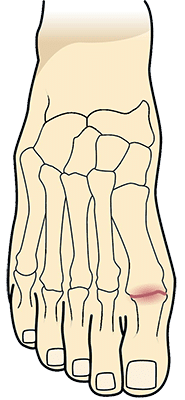
What is Hallux Rigidus?
Hallux rigidus is a type of degenerative arthritis that affects the big toe joint, more specifically the first metatarsophalangeal (MTP) joint, causing stiffness, pain, and limited range of motion. The condition gradually worsens over time and can cause significant disability and impairment of mobility if left untreated. Here’s what you need to know about hallux rigidus.
Causes of Hallux Rigidus
The exact cause of hallux rigidus is not known, but it is thought to be associated with overuse or wear and tear of the joint, or as a result of trauma to the area. People with certain structural foot abnormalities, such as flat feet or high arches, may also be more prone to developing hallux rigidus.
Symptoms of Hallux Rigidus
The most common symptoms of hallux rigidus include: pain and stiffness in the big toe joint, especially during activities that involve bending the joint, such as walking, running or climbing stairs. The pain may be mild to severe and can be accompanied by swelling and inflammation in the joint. As the condition progresses, the range of motion in the joint may become limited, making it difficult to move the toe up or down.
To diagnose hallux rigidus, a podiatrist will perform a physical exam of the foot and toe, looking for signs of stiffness, swelling or tenderness in the joint. They may also order X-rays to evaluate the degree of joint damage and assess the severity of the condition.
Treatment Options for Hallux Rigidus
The treatment options for hallux rigidus depend on the severity of the condition. In its early stages, conservative treatment methods may be effective in relieving symptoms and preventing further damage. These may include:
- Rest and immobilization: Avoiding activities that cause pain and wearing a rigid-soled shoe or brace to limit motion of the joint.
- Medications: Over-the-counter pain relievers or prescription medications to reduce inflammation and relieve pain.
- Physical therapy: Stretching and strengthening exercises to improve joint mobility and reduce pain.
In more severe cases, surgery may be necessary to relieve symptoms and improve joint function. Some surgical options include:
- Arthroplasty: Removal of part or all of the damaged joint and replacing it with an implant.
- Arthrodesis: Fusion of the joint to limit motion and relieve pain.
Hallux rigidus can be a painful and debilitating condition if left untreated. However, with proper treatment and care, most people can manage their symptoms and prevent further joint damage. If you are experiencing pain or stiffness in your big toe joint, contact our podiatrist to discuss your treatment options and find relief at 888-409-8006 or visit us online to schedule a consultation.
